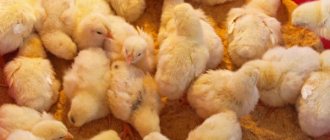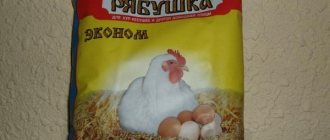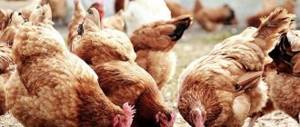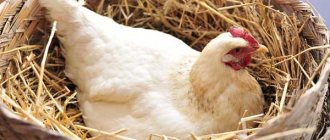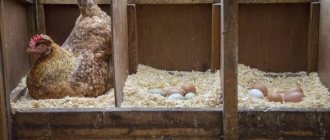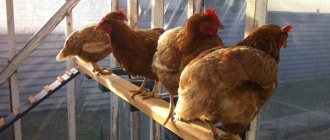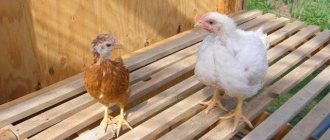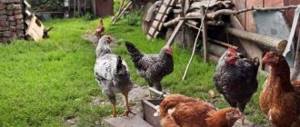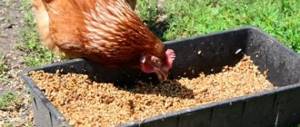When is the best time to feed laying hens?
In the intervals between morning and evening feedings, you can let cabbage or greens peck, hanging it on the walls or hanging it from the ceiling of the house so that the bird can reach it. Greens do not contribute to obesity, and birds peck at them with great pleasure. In the warm season, feeding can be done according to various regimes. Where the bird uses spacious walks covered with vegetation, it is enough to feed it once a day - in the morning. During a short night the bird will not get hungry. In autumn, when the bird can eat grains on the stubble, there is no need to feed it at all. Where there are no spacious walks, the bird needs to be fed more often than in winter, namely 3 times a day.
Daily feeding requirements for laying hens
The consumption rates for certain components are slightly different for each breed. Depending on the type of performance, the balance of nutrients differs. Let's look at approximate daily volumes.
- Wheat – 40-60 g;
- Corn – 20-40 g;
- Other cereals – 15-20 g;
- Potatoes, carrots, other vegetables – 70-100 g;
- Meal – 15-20 g;
- Meat and bone, fish meal – 10 g;
- Yeast, salt – 1 g;
- Greens – 30-40 g;
- Chalk, shell – 10-15 g.
Depending on the stage of development, taking into account the needs of the herd, you can slightly adjust the feeding norms for laying hens and the values we described. In the pre-laying phase, the protein content is increased, and after the end of the peak, more carbohydrates and fewer minerals are given.
To avoid miscalculations, beginners are advised to purchase ready-made, balanced feed mixtures that contain all the important ingredients for development and performance.
What to feed chickens
Chickens should be fed as often as possible: in the first days of life, 5-6 times a day. Then, until 3-4 weeks of age - 3-4 times a day. As they grow, depending on whether the chickens have the opportunity to get some of the food themselves, the number of feedings is determined.
The bird must be given as much feed as it needs to keep it healthy and productive. Lack of feed weakens the body and reduces productivity, and excess leads to obesity and also decreased productivity. Determining the required portion of food depends on the experience and observation of the owner. Experienced poultry farmers advise giving so much food so that the bird does not eat to its fullest and greedily takes the food to the next dacha. If she accepts food sluggishly, being quite healthy, the portion should be reduced.
What food is best for chickens
Depending on the properties of the food, it should be given in larger or smaller quantities. Birds eat less dry grain than soft food, vegetables and herbs. You cannot compare feeding grain feed and, for example, bran mixed with water. Much more of the latter will be needed to provide the bird with a small amount of nutrients. Great importance is also attached to the variety of food. It is better to give one or two types of grain as the main food, diversifying it with soft food for another dacha, and also additionally feed vegetables, herbs, and meat.
Chickens require a much more varied diet. At the beginning of life, they should be fed with animals and soft food, giving, of course, one or two types of grain. As you grow, the portions of grain increase, and the portions of animal feed decrease. Gradually, the number of food components is reduced, and the bird is content with those few types of food to which it has become most accustomed in recent times.
Types of feeding laying hens
There are several types of food for the feathered flock. You can choose any of them based on your capabilities.
- Dry
. As a rule, chickens are kept on dry rations in poultry factories and large farms, where the growing process is almost automated. It is practiced to supply exclusively dry concentrated and combined feed mixtures. - Wet
. Caring farmers, owners of small chicken coops, prepare wet mashes for their charges, which are rich in all the substances necessary for a full life, are easily digestible and satiate the birds. Feeding birds with wet mash helps improve their health, increase clutch rates and minimize losses. - The combined
type is perhaps the best option for all poultry farmers. Together with porridges and mashes, birds receive dry, whole and crushed grain. For a household, this type of feeding is the best.
Types of bird food
There are two main types of food: hard and soft. The first type includes mainly grains or grass seeds in their natural state, the soft type includes flour made from the same grains, as well as vegetables, various greens and animal feed. Grains and seeds soaked in water or scalded with boiling water should also be considered soft food. Often soft food is made from different types of flour, as well as bran with the addition of various boiled vegetables and herbs. Greens and vegetables are always given in chopped form, both boiled and raw. Flour is used to make mash with milk, whey or just water.
Soft feed is digested faster in the bird's body, so it is mainly used for fattening and raising chickens. It can be given to molting and convalescent birds in cases where enhanced and varied nutrition is required. Soft food is also fed in case of increased egg laying, but in moderation for fear of bird obesity. It is good to mix ginger and mustard with it, but with great care. First, give a small pinch, and then gradually increase the dose.
Soft food is used both cold and warm. In the warm season it can be cold, and in the cold - warm, so that there is no loss of heat in the body, the consumption of which at this time is greater than usual. The feed temperature should not exceed 40 °C. Soft food is given in a container that is easy for pecking; hard food can be given by scattering it on the floor of the room. This method of providing food is preferable, since the bird, while collecting it, at the same time produces some exercise, which is very important in winter, especially for those birds that are deprived of walking. You should not throw food on snow or frozen ground, or give it chilled in the cold. Compliance with these rules prevents diseases.
Bird feeding schedule
Successful poultry farming largely depends on the feeding regime. In winter, adult birds should be fed 2 times a day - morning and evening. In the morning you need to give soft and warm food, in the evening - dry grain. This rule is very important, since in winter there are short days and long nights. While sitting on perches at night, a bird that has eaten hard grains feels less of the effects of frost, since the activity of the digestive organs continues. In the intervals between morning and evening feedings, you can let cabbage or greens peck, hanging it on the walls or hanging it from the ceiling of the house so that the bird can reach it. Greens do not contribute to obesity, and birds peck at them with great pleasure.
In the warm season, feeding can be done according to various regimes. Where the bird uses spacious walks covered with vegetation, it is enough to feed it once a day - in the morning. During a short night the bird will not get hungry. In autumn, when the bird can eat grains on the stubble, there is no need to feed it at all. Where there are no spacious walks, the bird needs to be fed more often than in winter, namely 3 times a day.
Chickens should be fed as often as possible: in the first days of life, 5-6 times a day. Then, until 3-4 weeks of age - 3-4 times a day. As they grow, depending on whether the chickens have the opportunity to get some of the food themselves, the number of feedings is determined.
The bird must be given as much feed as it needs to keep it healthy and productive. Lack of feed weakens the body and reduces productivity, and excess leads to obesity and also decreased productivity. Determining the required portion of food depends on the experience and observation of the owner. Experienced poultry farmers advise giving so much food so that the bird does not eat to its fullest and greedily takes the food to the next dacha. If she accepts food sluggishly, being quite healthy, the portion should be reduced.
Depending on the properties of the food, it should be given in larger or smaller quantities. Birds eat less dry grain than soft food, vegetables and herbs. You cannot compare feeding grain feed and, for example, bran mixed with water. Much more of the latter will be needed to provide the bird with a small amount of nutrients. Great importance is also attached to the variety of food. It is better to give one or two types of grain as the main food, diversifying it with soft food for another dacha, and also additionally feed vegetables, herbs, and meat.
Chickens require a much more varied diet. At the beginning of life, they should be fed with animals and soft food, giving, of course, one or two types of grain. As you grow, the portions of grain increase, and the portions of animal feed decrease. Gradually, the number of food components is reduced, and the bird is content with those few types of food to which it has become most accustomed in recent times.
Is it possible to feed chickens millet? What should the diet consist of? Daily diet: food by weight.
In winter, chickens are given wet mash, to which grain, vegetables, and cake are added. Morning and evening feedings are carried out with the light on.
The menu is distributed as follows: Breakfast - soaked dry food with the addition of greens; Lunch - wet porridge; Dinner - dry whole grains with vitamin premixes.
In summer, chickens actively eat fresh grass on the run. Composition of feed for laying hens Every self-respecting poultry farmer pays a lot of attention to the composition of feed. To prepare porridges and mixtures, laying hens choose the healthiest grains: Various grains are added to the mash: corn, wheat, oats, barley.
Corn is rich in carbohydrates and fiber. Pre-crushed for better absorption; Wheat and its bran are the main source of vitamins E and B, plant-type protein; Barley - a lot of fiber, carbohydrates, amino acids, important for creating eggs; Oats and oat bran are easily digestible vegetable protein containing vitamins B, E, A.
Before serving, you need to crush and soak so as not to irritate the hens' esophagus.
Sources of animal protein and calcium to increase productivity and improve the quality of eggs are: Curdled milk, whey, light cottage cheese - added to mash; Fish and meat and bone meal - added to mash; Shredded meat and fish waste - cleaned of bones, boiled and crushed; Earthworms - dig yourself or buy dried ones in pet stores and put them in porridge when boiled; Beans and peas - put in small quantities into porridge or mixed with dry food, after soaking.
For meat types of chickens, choose options without premixes so as not to reduce weight gain. It is useful to give dried young nettles to laying hens.
The food breakdown of the daily norms for laying eggs per head will look like this: 10 g of bran; 6 g corn and beans; g barley, wheat, oats; 6 g animal protein including fermented milk products; g vegetables, root crops depending on the season; 10 g additives. Additives to the basic diet Additives in the diet of laying hens play an important role. Essential additives include grams per head per day: Meat and bone and fish meal - 1 g, Soybean and sunflower meal - 2 g, Sunflower and flax seeds - g, Vegetable, fruit and berry cakes - up to 4 g, Salt - 0, 5 g, Yeast - 1 g, Ground shell rock - 5 g, Chalk - 3 g, Herbal flour, pine flour - g.
A feeding shell must be included in the diet of laying hens. In addition to spoiled products, some other aspects need to be controlled: Every owner wants his laying hens to lay the most beautiful eggs, and their quantity, at the same time, does not dry out, therefore, when purchasing chickens at the poultry market, many farmers try to choose according to their opinion the largest and most viable ones, not realizing that little depends on the appearance of the chickens.
Winter feeding of chickens When trying to organize the winter maintenance and feeding of laying hens, it is important to remember that the quality of the feed will directly depend on how many eggs the farmer receives, and therefore it is necessary to include the following components in the winter diet of the poultry: Grain. Each chicken on the farm must consume at least 50 grams of fresh dried grain per day; Mash.
The daily intake of mash made from oatmeal and barley flour in a chicken’s diet should not be less than 30 grams; Potato. A healthy adult laying hen should eat at least 1 medium boiled potato per day; Cake.
Starting in the fall, every farmer must ensure that his farm has a certain amount of sunflower seed cake. The daily norm of cake per bird is no more than 7 grams; Hay, nettle. Dry crushed hay and nettles should also be present in the daily diet of the bird, their quantity is limited to 10 grams per bird; Dairy products.
Having this opportunity, the farmer is simply obliged to feed the chickens at least grams of whey, or yogurt, per day; Chalk, shells. To form eggshells, as well as bones and feathers, chickens need to be fed about 3 grams of chalk and shells daily; Bone flour.
An important component of the winter diet of chickens is bone meal, its amount should not be less than 2 grams; Salt. Regular table salt in the amount of 0. Spring feeding of laying hens With the first spring thaw, laying hens can be gradually transferred to spring housing, released outside, and fed more food rich in vitamins, including green. The spring norm of sprouted grain per laying hen is 40 grams.
The daily amount of feed required to feed one chicken in the spring should be approximately as follows: Grain.
A chicken should consume at least 50 grams of wheat, oats, or barley per day; Flour. A chicken should consume about 50 grams of bran, wheat, or oatmeal in the form of mash; Hay, straw - gram per chicken; Juicy and green food.
Grated beets, carrots and turnips in the amount of grams should be a mandatory component of the chicken’s spring diet; Waste. Cake, meat production waste and kitchen scraps are a source of protein and fat in the chicken body, therefore their consumption in an amount of at least 15 grams per chicken will not only not harm, but will also help increase the egg production of the bird; Egg shells, shells.
Mineral substances contained in eggshells and shells strengthen bird feathers; their inclusion in the chicken’s diet in an amount of 1 gram is mandatory; Salt, bone meal - 2. Feeding laying hens in summer Summer is the time when birds, especially chickens, are easiest to feed. What to feed chickens in the fall? This is the first 3 weeks after birth.
Now it is necessary to very carefully introduce new positions, as well as monitor the well-being and reaction of the cubs. As a rule, acceptable diet ingredients are a boiled egg, starter feed, greens, cottage cheese and vitamin supplements. The next period that we will consider is the phase of intensive growth and development, lasting from the third week of life until the 4th month.
As a rule, at this time young animals need nutritious, high-protein feed. The volume of food is gradually increased as you grow.
In addition, intensive growth is associated with increased needs for calcium and other minerals, so at this stage special attention is paid to the nutritional value of food. Before starting masonry, some more changes are introduced to the main menu. At this stage, laying hens begin to be prepared for the upcoming work, the nutritional value is gradually increased, and the composition of the food is enriched.
And of course, after the start of laying and throughout the entire period of peak egg production, the increased need for proteins and carbohydrates is taken into account. In addition, calcium is added daily, in the form of shells or chalk - about 10 grams for each worker.
After finishing the laying, the last change of diet is made. Gradually, laying hens lose their productive qualities and no longer require strict adherence to the rules.
Small errors in this phase are not as dangerous as in the previous ones. Types of feeding for laying hens There are several types of nutrition for the feathered flock.
What kind of grain do laying hens need?
As a rule, they are kept on dry rations in poultry factories and large farms, where the growing process is almost automated.
It is practiced to supply exclusively dry concentrated and combined feed mixtures. Caring farmers, owners of small chicken coops, prepare wet chicken coops for their charges, which are rich in all the substances necessary for a full life, are easily digestible and nourish the birds. Feeding birds with wet mash helps improve their health, increase clutch rates and minimize losses. The combined type is perhaps the best option for all poultry farmers.
Together with porridges and mashes, birds receive dry, whole and crushed grain. For a household, this type of feeding is the best. Needs of feathered workers Feeding standards for laying hens are drawn up based on their needs. Let's consider the main substances needed by the feathered family, as well as their sources.
Carbohydrates in the diet of laying hens Carbohydrates. Like humans, all living creatures need to receive energy from somewhere for life, activity and proper functioning of the entire organism.
Carbohydrates should make up the largest portion of the total food. To a greater or lesser extent, carbohydrates are found in almost all types of foods, but the greatest amount is in starchy vegetables and root vegetables, as well as in grain crops.
Proteins in feeding laying hens Proteins. A necessary component for muscle activity and egg formation.
In addition, protein is the main component of all cells, and its deficiency leads to disruption of tissue regeneration processes. It is imperative to supply animal and plant proteins to the feeders. Both are easily absorbed by avian organisms and are beneficial.
Small amounts of protein are present in many cereals, but legumes are the richest in this component. In addition, concentrated animal protein is meat, bone and fish meal.
Is it possible to feed chickens the following foods?
Fatty foods Fats. Another important menu item. Fats promote the absorption of certain vitamins, provide the chicken with warmth during cold weather, promote the growth of new feathers during molting, and are a component of eggs. The so-called cholesterol, which is often talked about in a negative way, is a material for cell membranes, so restoration processes do not occur without its participation. There are many fat-containing foods. In addition to being found in some cereals, they are also served separately.
Animal fats are found in broths, meat and fish trimmings. During the molting period, and for prevention, it is recommended to give fish oil to winged workers in its pure form, or as part of porridges and wet mash. Vitamins for laying hens Vitamins. Both people and birds need to consume all groups of vitamins to feel good.
Some vitamins are found in various foods, but each of them is rich in its own way. For example, B vitamins, important for hematopoiesis and maintaining the immune system, are found mainly in meat.
The fat-soluble ones, A and E, are found in fish and some plant foods such as pumpkin and carrots. Most of it is found in fresh herbs, vegetables, fruits and other plant products.
But it should be borne in mind that during heat treatment some of them lose their properties. Minerals Minerals.
The most important mineral in the hen menu is calcium. Without it, the formation of the skeleton, the health of the musculoskeletal system and normal egg laying are impossible. Calcium is found in large quantities in dairy products, so it is recommended to periodically give cottage cheese to birds and steam porridge with reverse milk. But even daily feeding with cottage cheese will not satisfy the chickens’ need for this element.
It is necessary to add chalk, crushed shells, and ready-made mineral preparations. Feeding regimen for laying hens Adequate nutrition also includes maintaining a stable regimen. The smallest ones need up to 8 meals a day, with a short break at night. In further phases, you can reduce the number of snacks to four. Active laying hens also need to be fed more often, for this reason it is recommended to feed them once a day.
What should the diet consist of?
In the summer, you can remove one meal if the winged family enjoys spending leisure time in a lush, green meadow. Green food will only be beneficial and will eliminate the risk of developing obesity. In winter, especially on the coldest days, it is better to feed the birds more often so that they do not become hypothermic. Daily feeding norms for laying hens Consumption norms for certain components are slightly different for each breed. Winter and Summer Different seasons bring changes in food choices.
When purchasing chickens, not everyone understands how to feed the bird correctly, and this directly determines what you get in the end - good egg production or a large chicken mass. There are fundamental differences between feed for laying hens to increase egg production and feeding broilers to obtain increased bird weight.
In these schools, everyone was taught the basics of poultry farming. The textbooks most often used were the books of the famous Russian poultry farmer I.
Chapter 3. It is we, people, who recklessly eat everything, regardless of the nutritional value of the food. We often eat food that is of poor quality and completely unhealthy for our body. And in response to the warnings of doctors and nutritionists, we simply wave our hand, saying that everything will work out.
Here, for example, is what he wrote about poultry feed. Poultry feeds mainly on a variety of grains. In addition, they eat the stems of various herbs and their seeds, as well as the leaves of many trees and shrubs. Various vegetables, berries and fruits serve as a treat for them. In addition to plant foods, poultry eat animal foods.
They eat a lot of earthworms, slugs, various insects and their larvae. They eagerly eat fish and meat of various animals, crushed bones, and frogs. This omnivorous nature makes it easier to keep poultry and helps reduce the cost of their food. Grain feed serves as their main food; the rest of the feed can be called supplementary feed.
It goes without saying that the grain feed must be of good quality, that is, not rotten, not spoiled by worms, not burnt, etc. To do this, it must be collected, crushed and dried in a dark place. The optimal dose is g per day per head. In winter, it is better to reduce the consumption rate of elodea to 100 g. Well-digestible protein is contained in pondweed.
In itself, this is an underwater plant, but the bulk of the leaves are on the surface of the reservoir, therefore it is one of the common food items for waterfowl. There is another underwater plant called hara, or lice. Hara grows in the deepest places of reservoirs. In addition to protein, it contains many minerals. Young animals at the age of 5 days can be given crushed or soft aquatic vegetation.
The optimal dose for them is g per head per day. For adult birds - Fruits of woody plants In autumn and winter, acorns, beech nuts, rowan berries and horse chestnut fruits can be added to the diet of poultry. Rowan is very useful for birds, primarily because it contains a lot of vitamins A and C. Just as a person eats rowan to avoid getting sick, birds need to be fed these fruits to prevent colds.
Another value of ripe rowan berries is that they diversify the diet of birds. Acorns can also add variety to the feed. They contain little protein, but plenty of carbohydrates and fats. When feeding acorns, they must be dried and ground. If you feed acorns to laying hens, the whites in the eggs they lay will have a dark tint.
Therefore, add them to the diet when the birds’ productive period ends. The rate of consumption of acorns by birds is g per day per head. Horse chestnuts are prepared in the same way as acorns. Before feeding beech nuts to the birds, they must be roasted. The fact is that they contain a toxic substance, and it can only be destroyed by thoroughly frying the nuts.
The optimal dose of beech nuts is g per bird per day. Root vegetables Root vegetables include beets, carrots, turnips, rutabaga and pumpkin.
They contain a lot of carbohydrates, but lack calcium and phosphorus. Also, there is practically no carotene in root vegetables, which is very necessary for the normal development of young animals. Of all the above plants, only carrots, especially bright red ones, contain carotene. In general, carrots are a dietary and vitamin food for all types of poultry.
The main thing is not to feed the bird carrots that have been sitting for a long time, since in this case all its nutritional values are lost. Fresh or slightly dried carrots should be chopped and added to the mash.
Ground raw carrots are added to the diet based on the optimal dose - g per head per day. You can also pickle carrots. To do this, you need to thoroughly wash and chop the vegetables.
Then place the pieces of carrots in a tub, which must first be buried in the ground. Sugar beets are very useful if you want to increase the live weight of your birds. Before feeding, it is better to boil the beets and lightly chop them.
Young animals need to be introduced to beets gradually. You can freeze beets to feed birds in the winter. In this case, it cannot be stored thawed for a long time.
Birds can easily be poisoned by such beets, as nitrogen and nitrite accumulate in them. The optimal dose for chickens is 50 g, for ducks and turkeys - g, and for geese - g per head per day. Pumpkin is rich in carotene, sugar and vitamin B2. This is a very healthy and nutritious product for birds. Like all other root vegetables, it is better to boil and chop beets before feeding. The most common tuber crop in agriculture is potatoes.
Plant-based feed for chickens
Feeds of plant origin include grain feeds, industrial processing waste (flour milling, oil milling, beet sugar), green, succulent feeds, and hay.
Grain feed forms the basis of the bird's diet. From grain feeds, birds are fed: oats, barley, corn, rye, millet, buckwheat, peas, vetch, sunflower seeds, flaxseed and, in addition, waste obtained from grain processing (bran, sweep, chaff, flour dust) and oil mill industry (cake, meal).
Oats for laying hens
Oats are the main grain feed in some areas. It is fed to both adult breeding birds, especially during oviposition, and to young animals. The disadvantage of this feed is the large number of films, reaching up to 30-40% of the weight of the total grain. Chickens should be given oats in ground and sifted form. It stimulates feather growth. Good oats should be large, white or light yellow in color, dry, with a moisture content of no more than 30%. Oats are also fed in sprouted form.
Barley for laying hens
Barley can be included in the diet along with other grain feeds. Birds eat it less readily than corn or wheat. It is better to get used to it from a young age. In areas where barley is a common crop, it can serve as a major component of the grain diet. Good barley should be full-grain and thin-skinned, light yellowish-white in color, with some shine, a fresh strawy smell, without mustiness. It is fed as part of a flour mixture and in its entirety.
Corn for chickens
Corn is a valuable grain feed, most readily eaten by poultry, especially chickens. Due to its high content of carbohydrates and fat, it is considered a good feed for fattening; it is easily digested. In areas where corn is primarily grown, it is a component of almost every diet and is fed either whole or coarsely crushed or ground.
However, the protein in corn is considered deficient in certain amino acids. In addition, it is poor in minerals, especially calcium, so it is better to feed a mixture of grain feeds. When feeding corn to an adult bird during egg-laying in the warm season, it should not be introduced into the diet in large quantities, as this contributes to obesity; in the cold season, the risk of obesity decreases.
Rye for chickens
Rye is similar in composition to wheat, but is relatively poorly eaten by birds, especially in its whole form. When feeding poultry with wet mash, rye is added in ground or steamed form. Rye flour is included in fattening rations and during the first fattening period.
Millet for laying hens
Millet is close in composition to oats. It is fed whole and ground, as well as hulled (millet). Millet is given to chickens in the form of hard-cooked crumbly porridge. Ground millet can be included in grain mash.
Which grain is best for chickens
To provide your feathered pets with a balanced diet, a sufficient amount of minerals and vitamins, their diet needs to be varied. The bird should receive both wet food (mash) and chopped vegetables.
But the basis of the diet is grain:
- Wheat is ideal for laying hen productivity. Rich in B vitamins and tocopherol;
- triticale (a hybrid of wheat and rye) - a high percentage of protein in the composition, rich in minerals. Suitable for chickens of both directions;
- oats - thanks to amino acids, helps to recover after shedding. A source of valuable microelements (calcium, sodium, iron), promotes weight gain;
- corn - quickly digested, nutritious. Suitable for meat chickens;
- barley - supplies the body with fiber, acids and carbohydrates, promotes shell strength.
Rye is used extremely rarely because it contains a large amount of mucilaginous substances. If it is introduced into the diet due to the lack of other grains, then no more than 7-8% of the total diet. Millet, due to its record amount of fiber, is given only to adults and then no more than 10% of the diet.
Did you know? In China, the Golden Rooster Film Award was established in 1981.

